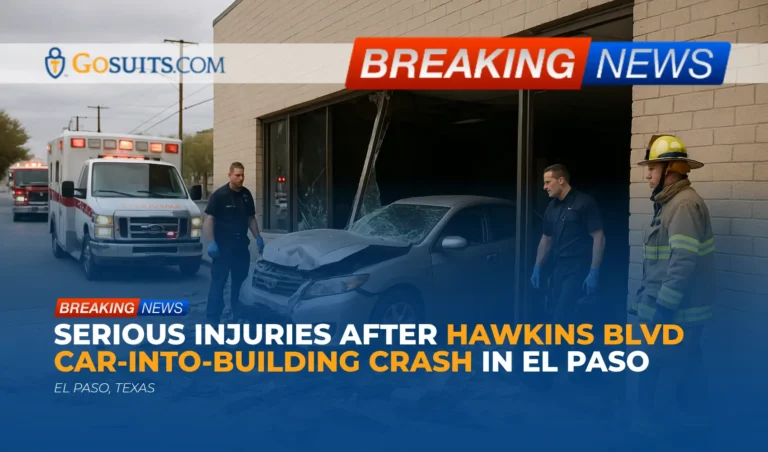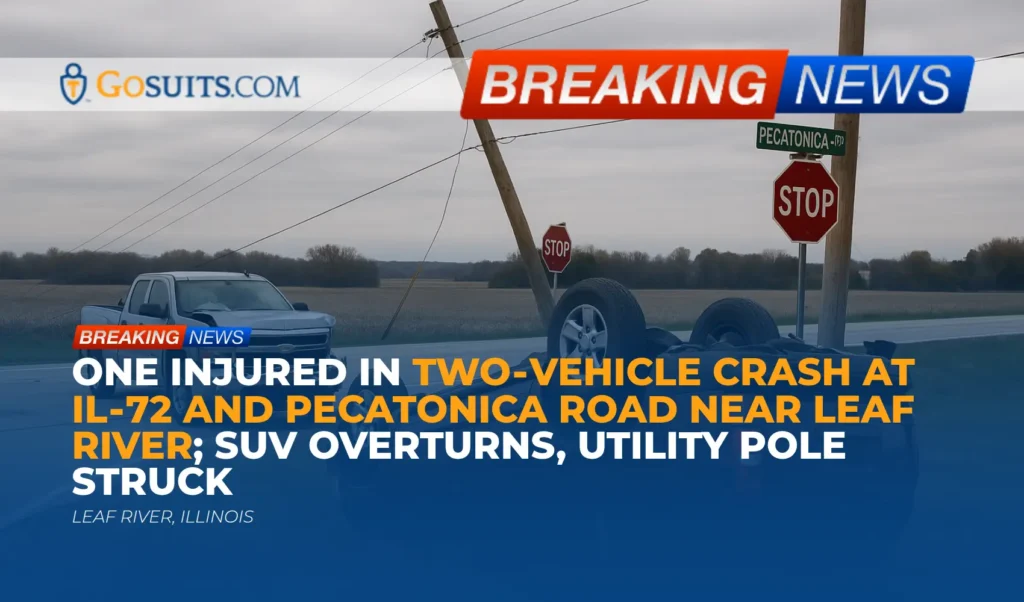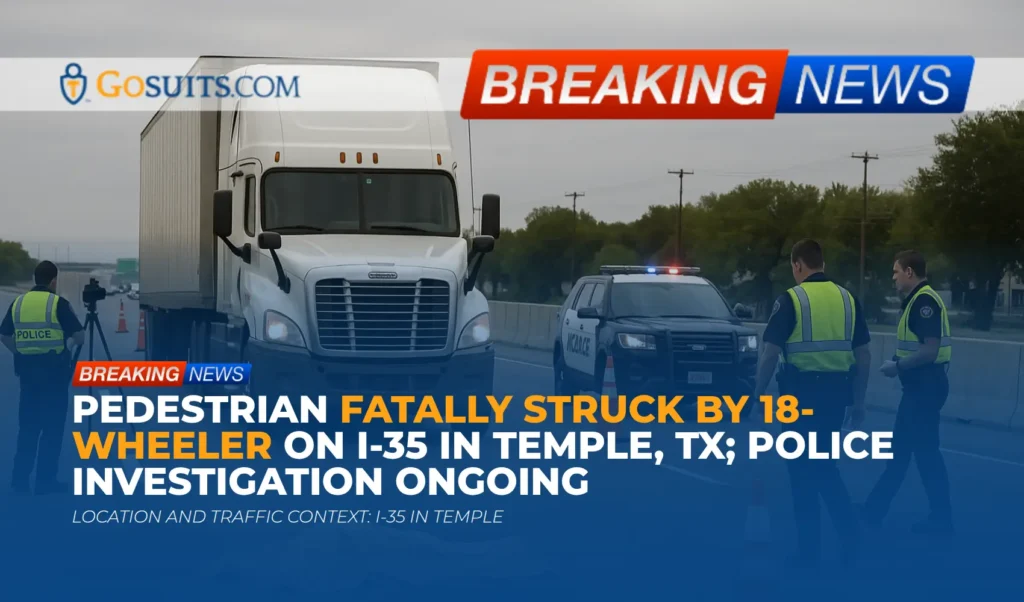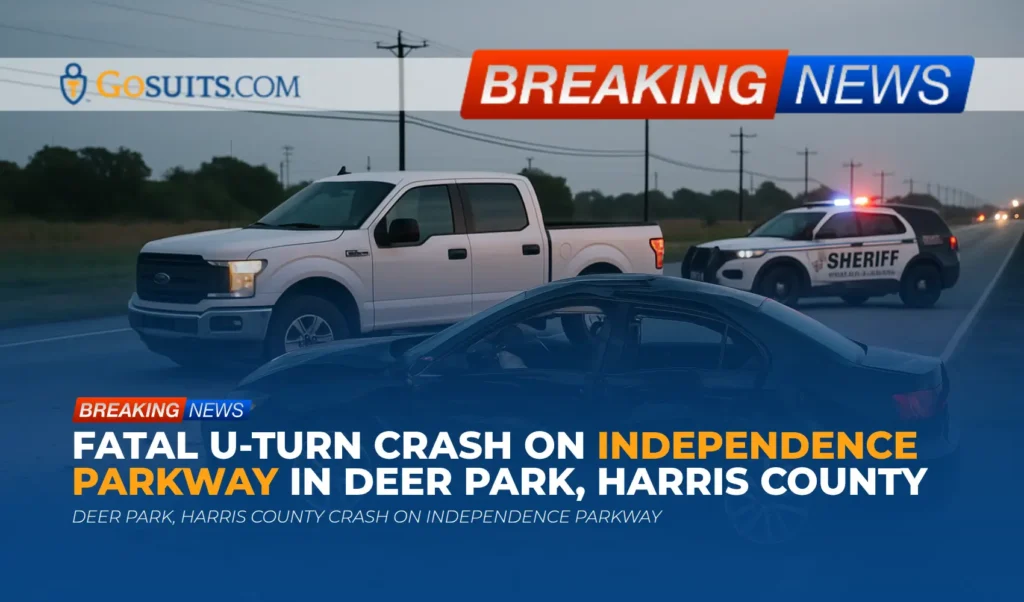- What we know about the Hawkins Blvd crash in El Paso
- Emergency response and initial reports
- Why vehicle-into-building crashes are so dangerous
- Texas civil liability overview for crashes into buildings
- Key evidence to preserve after a serious crash
- How to obtain official records in El Paso and Texas
- Insurance considerations and common pitfalls
- Timing, deadlines, and why acting promptly matters
- Community safety and prevention near Hawkins Blvd
- Commentary from Gosuits El Paso, Texas Personal Injury Attorney
- Why timely action matters and practical next steps
What we know about the Hawkins Blvd crash in El Paso
On Monday afternoon, October 21, 2025, a serious single-vehicle crash occurred along Hawkins Blvd in East El Paso. According to initial reports, a blue vehicle was captured on dashcam video speeding through a stop sign, striking the median, going airborne, and crashing into a nearby building. The El Paso Fire Department responded at approximately 3:19 p.m. after multiple 911 calls. First responders requested a high-priority medical response. Although an air ambulance was initially considered, the injured individual was transported by ground ambulance to a local hospital. The patient was classified as code 3 for serious injuries that require urgent care. The precise nature of those injuries has not been disclosed at this time.
Hawkins Blvd includes a mix of commercial and residential properties, which increases the risk to people inside structures and to pedestrians when a vehicle departs the roadway. Serious incidents like this affect not only the person in the vehicle but also anyone nearby, including building occupants and workers who may face sudden danger and significant property damage.
Emergency response and initial reports
Multiple 911 calls brought a rapid response by the El Paso Fire Department. Code 3 designations are used in emergency services to prioritize the most urgent cases. While specific clinical details are not public at this time, the designation indicates a need for immediate treatment and transport. Aerial transport was considered but ground ambulance ultimately provided the hospital transfer.
Crashes with this kind of energy transfer often involve a combination of harms, including blunt force trauma, fractures, internal injuries, and head, neck, or spinal injuries. In the aftermath, EMS evaluates airway, breathing, circulation, disability, and exposure, while stabilizing and coordinating with receiving hospitals. The transition from scene to hospital is only the start of what can be a lengthy medical and personal recovery.
Why vehicle-into-building crashes are so dangerous
Although less common than typical roadway collisions, a crash that carries a vehicle over a curb, across a sidewalk, and into a building concentrates a large amount of force into a confined space. Structural elements, storefront glass, and interior fixtures do not absorb crash energy like automotive safety systems, which increases risk to both vehicle occupants and anyone inside the structure.
Two safety factors highlighted by this incident are speeding and stop sign compliance. National roadway safety research consistently finds that higher speeds increase crash likelihood and dramatically worsen injury severity. The National Highway Traffic Safety Administration notes that speeding impairs a driver’s ability to negotiate curves, reduces effectiveness of protective equipment, and increases both stopping distance and crash forces. See NHTSA’s overview of speeding risks at NHTSA speeding.
Stop signs are placed to allocate right of way and prevent conflicts, especially near intersections and medians. The Federal Highway Administration’s Manual on Uniform Traffic Control Devices explains the purpose, placement, and design of STOP signs to ensure consistent driver recognition and compliance across jurisdictions. Details are available at FHWA MUTCD STOP signs. When drivers fail to stop, the risk of losing control rises, particularly in urban corridors where medians, curbs, and driveways create frequent points of conflict.
Beyond immediate injury, vehicle-into-building crashes can compromise structural integrity, utilities, and fire safety. Collisions may damage load-bearing walls, dislodge gas lines, or expose electrical hazards. Post-incident inspections by building officials or qualified engineers are often necessary to determine if the structure is safe to reoccupy.
Texas civil liability overview for crashes into buildings
In Texas, civil liability for motor vehicle crashes generally follows principles of negligence. A person who fails to use ordinary care and thereby causes injury or property damage may be held responsible. The Texas Transportation Code sets out duties applicable to drivers that often frame evidence of negligence in traffic cases. Two provisions particularly relevant here include:
- Duty to stop at stop signs. Texas Transportation Code section 544.010 requires drivers to stop at a stop sign and yield the right of way to vehicles in or approaching the intersection in compliance with the law. See the statute at Tex. Transp. Code § 544.010.
- Safe speed and control. Texas Transportation Code section 545.351 requires drivers to operate at a speed that is reasonable and prudent under the circumstances, with special attention to actual and potential hazards, and to control speed to avoid colliding with any person or vehicle. See Tex. Transp. Code § 545.351.
Depending on the facts, potential civil claims may include:
- Personal injury claims by the injured driver or other injured persons. These can involve medical expenses, lost income, and pain and suffering, subject to Texas law and the evidence available.
- Property damage claims by the building owner or tenants. A vehicle striking a building can lead to substantial repair costs, loss of use, and business interruption. Property owners may seek recovery from the at-fault driver’s liability insurer.
- Third-party responsibility in specific circumstances. If the driver was on the job at the time of the crash, an employer may face responsibility under respondeat superior. If vehicle defects or unsafe roadway conditions contributed, responsibility could involve other parties. Identifying such issues requires careful, fact-based investigation, accident reconstruction, and analysis of maintenance, signage, and design.
Texas uses proportionate responsibility in many negligence cases, which allocates fault among parties based on comparative negligence principles. The specific application depends entirely on the facts and evidence developed.
Key evidence to preserve after a serious crash
Evidence preservation often makes the difference in proving what happened and in protecting the rights of those affected. Consider these sources:
- Dashcam and surveillance video. The incident description mentions dashcam footage showing the vehicle running a stop sign. Video from private vehicles, storefronts, and nearby homes often overwrites within days. Promptly requesting preservation from businesses and property managers can be crucial.
- 911 calls and dispatch logs. These can help establish timing, observed driving behavior, and early witness statements.
- Police crash report and scene documentation. In Texas, reportable injury crashes are typically documented on an officer’s CR‑3 crash report, which can be obtained through the state system.
- Fire and EMS run reports. First responder records can provide details about injury severity, extrication, and on-scene observations.
- Vehicle data. Modern vehicles often store event data that can shed light on speed, braking, and throttle just before impact. Preservation may require timely action.
- Medical records and imaging. Hospital and clinic records document injuries, diagnostics, and treatment plans. Federal rules establish a right to access medical records. The U.S. Department of Health and Human Services explains patient access rights at HHS HIPAA right of access.
- Structural assessments and repair documents. Building inspections, permits, and contractor reports help quantify damage and causation for property claims.
- Witness information. Names, phone numbers, and brief written statements can anchor an accurate timeline while memories are fresh.
Because what someone says to an insurer or investigator can later be used to challenge a claim, it is wise to consult a qualified attorney first, especially before giving recorded statements.
How to obtain official records in El Paso and Texas
Official records establish a neutral, factual backbone for what happened. Here are reliable ways to request them in El Paso and statewide:
Police crash reports
- State CR‑3 crash report through TxDOT. For crashes that involve injury, a Texas Peace Officer files a CR‑3. Copies are available online through the state’s system. See the TxDOT Crash Report Online Purchase System at TxDOT CRIS purchase.
- City of El Paso records. The City of El Paso provides public information request options for incident-related materials that are releasable under the Texas Public Information Act. Visit the open records portal at City of El Paso Open Records.
Fire and EMS records
- El Paso Fire Department records. Certain incident and EMS records may be available subject to privacy laws. Requests can be made through the city’s public records process at City of El Paso Open Records.

Medical records
- Hospitals and clinics. Patients have a right to access their medical records. HHS provides guidance on the right of access and typical time frames for fulfillment at HHS HIPAA right of access.
Building and property records
- Inspections and permits. If a structure was struck, documents from building officials and permit records can be important for property claims. For city information on building permits and inspections, start here: City of El Paso Building Permits and Inspections.
- Code enforcement. Where safety issues arise, code enforcement records may be relevant. City resources are available at City Code Compliance.
If a fatality occurs
This incident involves serious injuries rather than a reported fatality. In the event of death following an incident, families often need death investigation documents and autopsy reports from the county medical examiner’s office. Procedures and availability are governed by state and local law, and requests are often made through local public information processes.
Insurance considerations and common pitfalls
Insurance issues become complex quickly when a vehicle leaves the roadway and strikes a structure. Multiple policies may be involved, including the driver’s liability coverage, optional personal injury protection or medical payments, uninsured or underinsured motorist coverage, commercial policies if a business vehicle is involved, and the property owner’s carrier for building damage.
The Texas Department of Insurance provides plain-language resources on auto policies, claim handling, and consumer rights. See TDI’s consumer information on auto insurance at TDI auto insurance.
Practical points to consider:
- Talk to an attorney before you talk to insurers. Statements to any insurer can be used to limit or deny a claim later. Consulting an attorney first can help clarify rights and prepare for recorded statements or examinations under oath.
- Use the official crash report. The police CR‑3 report often anchors liability discussions. Obtain it through the state system at TxDOT CRIS.
- Preserve medical billing and records. These documents substantiate injury claims and help organize benefits, liens, and medical pay provisions. HHS explains access rights at HHS HIPAA right of access.
- Watch for quick settlement offers. Early offers can come before injuries and costs are fully known. Settling too soon can leave future expenses uncovered.
- Property damage for buildings. Building owners and tenants often coordinate with their property insurer for emergency stabilization and repairs, while the insurer may seek reimbursement from an at-fault driver’s carrier.
- Optional coverages in Texas. Texas policies may include personal injury protection or medical payments that help with immediate medical costs, regardless of fault, if purchased. Uninsured or underinsured motorist coverage can be vital when the at-fault policy limits are insufficient. TDI provides guidance at TDI auto insurance.
Insurance companies are sophisticated claim handlers. Having a knowledgeable advocate can help level the playing field, clarify benefits, and avoid common missteps that can diminish the value of a claim.
Timing, deadlines, and why acting promptly matters
Texas law sets deadlines for filing civil lawsuits. As general background, many personal injury claims in Texas must be filed within two years of the incident. See Texas Civil Practice and Remedies Code section 16.003 at Tex. Civ. Prac. and Rem. Code § 16.003. Some claims, especially those involving government entities or unique circumstances, can involve different notice requirements and shorter timelines.
Acting promptly has other practical benefits:
- Video is erased quickly. Many businesses overwrite camera footage within days or weeks. Early preservation requests can secure critical evidence.
- Vehicles get repaired or scrapped. Once a vehicle is altered, retrieving event data and documenting damage patterns becomes harder.
- Witness memory fades. Statements captured early are clearer and more detailed.
- Medical follow-up matters. Timely care helps both recovery and documentation. Gaps in treatment can complicate claims and clinical outcomes.
Community safety and prevention near Hawkins Blvd
Urban corridors like Hawkins Blvd serve drivers, pedestrians, and businesses in close proximity. Preventing similar crashes often involves a combination of driver behavior, enforcement, and design.
- Driver behavior. Compliance with stop signs and posted speeds is fundamental. NHTSA emphasizes that higher speeds reduce reaction time and increase crash severity. See NHTSA speeding.
- Consistent signage and visibility. The FHWA’s MUTCD provides standards to enhance recognition and compliance with STOP signs, including size, placement, and supplemental plaques where justified. Reference FHWA MUTCD STOP signs.
- Roadside protection. In some locations, protective measures such as reinforced bollards or barriers may be considered to reduce intrusion into storefronts. The suitability depends on site-specific engineering evaluations and local standards.
- Community reporting. Residents and businesses can report recurring hazards or near-misses to local authorities. The City of El Paso’s code and public works teams can assess localized safety concerns and coordinate with state and regional partners as needed. For general city resources, see City of El Paso.
Safety is a shared effort. While enforcement and engineering play critical roles, the most immediate protective step comes from drivers who slow down, scan intersections, and approach medians with care.

Commentary from Gosuits El Paso, Texas Personal Injury Attorney
Our hearts go out to the person seriously injured in this Hawkins Blvd crash and to everyone who was nearby when a vehicle entered the building space. Events like this are sudden and frightening, and the path ahead can feel overwhelming. This commentary is offered for general educational purposes and to help the community understand common legal and practical issues that follow.
From a personal injury perspective, early information suggests high speed and a missed stop sign were involved, which aligns with well-documented risk factors. In Texas, duties to control speed and to stop at posted signs establish clear safety expectations for all road users. When a vehicle leaves the roadway and damages a structure, the repercussions span far beyond the driver, reaching building owners, tenants, and pedestrians. The investigation should carefully examine video, scene measurements, and vehicle data to establish the sequence of events without speculation.
Insurance carriers and large corporations manage claims every day. They know how to frame statements, interpret medical records, and leverage procedural rules to minimize what they pay. People who are injured, or whose property is damaged, often do not know which records matter most, how to preserve key video before it disappears, or how policy exclusions and sublimits can affect recovery. Recorded statements, medical authorization forms, and quick settlement checks are common pressure points that can limit options. Having a seasoned advocate explain rights before any insurer communication can prevent serious missteps.
A free consultation can be an important first step in understanding what is at stake, identifying all potential insurance coverages, and developing a plan to gather the right evidence. It also provides a safe setting to ask questions about timelines, medical billing, and documentation. Knowledge empowers better decisions in the days and weeks after a serious crash.
Why timely action matters and practical next steps
The period immediately after a serious crash is critical for safety, health, and documentation. Taking the right steps can protect legal rights, maintain access to benefits, and prevent the loss of irreplaceable evidence.
- Prioritize medical care and follow-up. Attend all appointments, follow medical advice, and keep copies of discharge summaries and imaging. Timely care supports recovery and creates reliable records of injury and treatment.
- Preserve video and digital evidence immediately. Request that nearby businesses and property managers preserve surveillance footage. Save dashcam files to a secure location and back them up.
- Obtain official reports. Request the Texas CR‑3 crash report from the state system and seek releasable records from the City of El Paso for police and fire response. Official records anchor the facts of what happened.
- Document property damage thoroughly. Photograph vehicle and building damage from multiple angles, track all repair estimates, and retain invoices. If a structure was struck, secure any post-incident inspections or engineer assessments.
- Speak to an attorney before speaking to insurers. A brief, no-cost consultation can help identify coverages, prepare for recorded statements, and avoid unknowingly limiting a claim. What is said to an insurance company can be used later, so preparation matters.
- Track all out-of-pocket costs. Keep receipts for medications, transportation to medical visits, temporary accommodations if a building was made unusable, and other crash-related expenses.
- Be mindful of deadlines. Texas law sets time limits for bringing claims, and some matters require earlier notice. Acting now helps preserve options later.
- Seek support for emotional well-being. Serious incidents can trigger stress responses. If helpful, consider reaching out to a trusted healthcare provider or a crisis support resource. Federal resources for emotional support during crises are described at SAMHSA Disaster Distress Helpline.
Taking these steps promptly helps ensure safety, preserves the evidence needed for accurate decision-making, and reduces the risk of avoidable claim problems later on.






